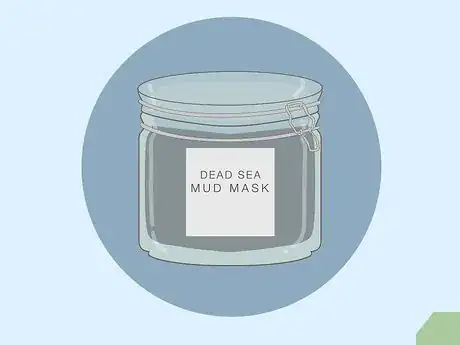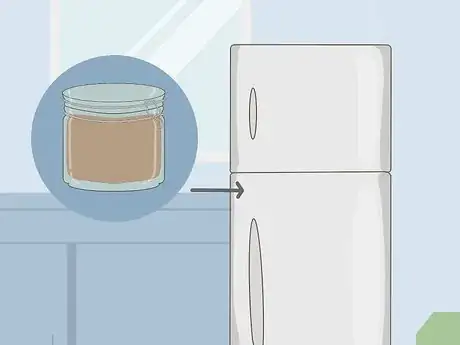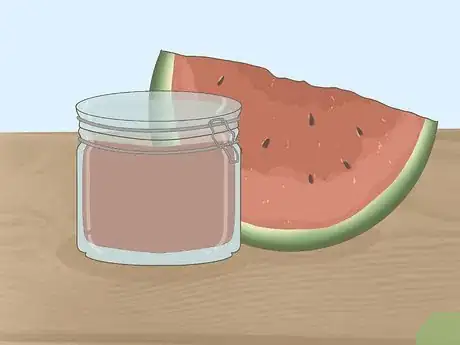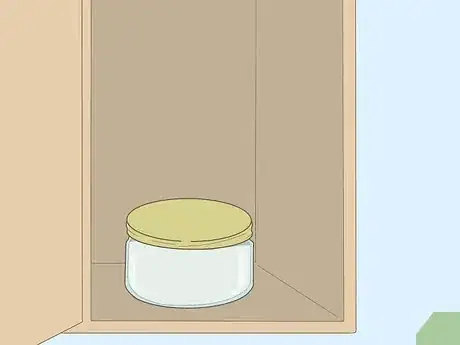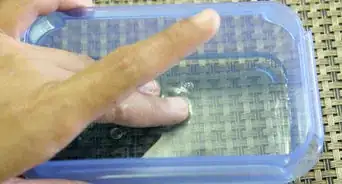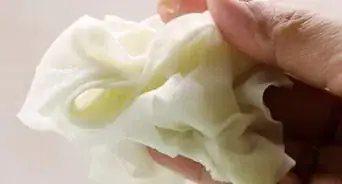This article was co-authored by Mohiba Tareen, MD. Mohiba Tareen is a board certified Dermatologist and the founder of Tareen Dermatology located in Roseville, Maplewood and Faribault, Minnesota. Dr. Tareen completed medical school at the University of Michigan in Ann Arbor, where she was inducted into the prestigious Alpha Omega Alpha honor society. While a dermatology resident at Columbia University in New York City, she won the Conrad Stritzler award of the New York Dermatologic Society and was published in The New England Journal of Medicine. Dr. Tareen then completed a procedural fellowship which focused on dermatologic surgery, laser, and cosmetic dermatology.
There are 13 references cited in this article, which can be found at the bottom of the page.
This article has been viewed 29,725 times.
Treating yourself to a face mask is a simple way to relax and rejuvenate your skin. How you store a face mask depends on whether its ingredients are shelf-stable or require refrigeration. It’s best to keep store-bought face masks in their original containers. However, you may need to use a plastic zipper bag or glass jar with an airtight lid if the package becomes damaged or if you want to store leftovers from a homemade face mask. Storing face masks properly ensures you’ll have many more pampering sessions to come—your skin will thank you!
Steps
Preserving Creamy Premade Masks
-
1Keep single-use face masks in a cool, dry place. If you buy small packets of creamy face masks, keep them in a drawer or cupboard in your bathroom. Make sure they're out of direct sunlight and away from sources of heat.[1]
- For instance, face masks are best stored in a drawer far away from the shower or from the area where you blow-dry your hair.
-
2Make sure the container is fully closed. If the face mask is in a squeeze bottle, be sure to close the cap so it's sealed. Inspect the cap of squeeze bottles to ensure the top can fully close. You may need to wipe away any residue around where the mask squeezes out to ensure a tight fit.[2]
- If the face mask is in a small jar, twist the top to the right as far as you can to ensure it's airtight.
- If the cap or lid of the face mask is cracked or damaged, place the container in a plastic zipper bag. Squeeze out all of the air before you seal it.
- Masks containing vitamin C and vitamin A especially need to be airtight because the vitamins can deactivate at a faster rate when they’re exposed to air.
Advertisement -
3Preserve clay or mud-based face masks in an airtight, non-metallic jar. If you bought a face mask that says "living clay" on the container, it's best to keep it in the container it came in. It will either be made from opaque glass, ceramic, or stone. Make sure the lid is screwed on tight.[3]
- Place the container in a drawer at room temperature. Don’t put it in the refrigerator because it can harden the clay, making it more difficult to scoop out when you’re ready to use it.
- For long-term storage, open the lid and use a clean spoon or your finger to scrape the sides and the rim of the container. Incorporate the side scrapings into the main body of the product to keep it from going dry.
- Clay-based face masks can get thicker the longer they sit around, so add water if you want to loosen it up and make it easier to apply.
-
4Store eye masks in the door of your refrigerator for extra benefits. When it comes to de-puffing your eyes in the morning, putting eye creams and serums in the fridge is ideal. Make sure the jar or lid is sealed. If any part of the package or container is damaged, place it in a plastic zipper bag, squeeze out the air, and seal it.[4]
- However, if the package says to store it at room temperature, do that.
- Cooling down the cream or serum will help de-puff your eyes even more.
Keeping Homemade Masks Fresh
-
1Store masks made with dairy or vegetables in the refrigerator for 2 to 3 days. If you've made a mask from pumpkin, yogurt, eggs, or milk, scoop any leftovers into an airtight glass jar or plastic container and refrigerate it. The enzymes and probiotics in these ingredients will stay active for up to 3 days, so be sure to use the mask quickly.[5]
- Don't use metallic jars as some of the metallic enzymes may seep into the mixture.
-
2Preserve fruit-based masks in an airtight container in the refrigerator. If you've made a mask from papaya, apple, banana, watermelon, kiwi, avocado, or strawberry, use a spoon to scoop the leftovers into an airtight glass jar or plastic container. The mask will stay fresh for up to 1 week.[6]
- To make avocado-based masks last longer, squeeze a little lemon juice onto the mixture or place the pit of the avocado into the mixture.
-
3Leave oil-based masks at room temperature in a sealed container. Masks made from coconut, olive, or any other kind of oil should be stored just like you would the oil itself. Scoop the leftovers into an airtight glass container and place it in the cupboard away from heat or light.[7]
- However, if you add any perishable ingredients like fruit or vegetable puree, place the sealed container in the refrigerator. Take it out of the fridge about 15 to 20 minutes before you plan to apply the mask so it won't be hard or clumpy.
- Oil-based masks with other non-perishable ingredients (like essential oils, vitamin E, honey, or shelf-stable fruit extracts) will technically stay fresh for up to 2 years. But it’s best to use the homemade mix right away.
-
4Add natural preservatives to your homemade masks to extend their shelf life. Grapefruit seed extract, vitamin E oil, and aloe vera are excellent natural preservatives that can keep your homemade face masks fresh for longer. Add 3 to 4 drops of grapefruit seed extract or vitamin E oil or incorporate a scoop of aloe vera gel into your face masks for longevity.[8]
- You can buy vitamin E oil at most drugstores or any beauty supply store. If they only have capsules, split 1 capsule with a knife and use a few drops.
- Grapefruit seed extract can be found online, at grocery stores with a natural beauty section, or most beauty supply stores.
Storing Sheet Masks
-
1Read the instructions on the package to see how you should store it. Every face mask has different ingredients, so refer to the manufacturer's directions on the package to see the best way to store the product. Putting face masks in the refrigerator will affect the viscosity of the ingredients.[9]
- For instance, a face mask containing coconut oil that's been refrigerated may freeze and not function as well as it would if it had been stored at room temperature.
-
2Keep sheet masks in a cool, dry area out of direct sunlight. Place your sheet masks in a drawer or cupboard in your bathroom. If possible, pick a spot away from your shower so the mask won’t be slightly heated by the steam.[10]
- If a sheet mask is left in a warmer temperature or in the sun, it could dry out and lose it’s skin-benefiting effects.
- While it's common, you shouldn't store your sheet masks in the refrigerator. The frigid temperature can freeze the ingredients and affect how the mask works.[11]
-
3Lay single-package sheet masks horizontally. Don't store your masks vertically in a drawer or cupboard. Lay each packet horizontally so the serum inside the package is evenly distributed on the inner sheet.[12]
- Make sure there’s nothing heavy on top of them so the airtight packages don’t accidentally pop open or tear.
Warnings
- Don’t use a face mask that has expired because the chemicals break down over time and may irritate your skin, resulting in a rash or other allergy symptoms.[14]⧼thumbs_response⧽
References
- ↑ https://fashionmagazine.com/face-body/beauty-products-refrigerator/
- ↑ https://www.beautylish.com/a/vxicj/beauty-products-in-refrigerator
- ↑ https://www.ncbi.nlm.nih.gov/pubmed/17342267
- ↑ https://fashionmagazine.com/face-body/beauty-products-refrigerator/
- ↑ https://journals.lww.com/pbj/fulltext/2017/05000/topical_use_of_probiotics__the_natural_balance.1.aspx
- ↑ https://livesimply.me/strawberries-and-yogurt-brightening-facial-mask/
- ↑ https://www.homestratosphere.com/how-to-store-coconut-oil/#Coconut_Oil_Storage
- ↑ https://www.aocs.org/stay-informed/inform-magazine/featured-articles/the-preservative-wars-february-2013
- ↑ https://youtu.be/I2faeTzWjbQ?t=121


